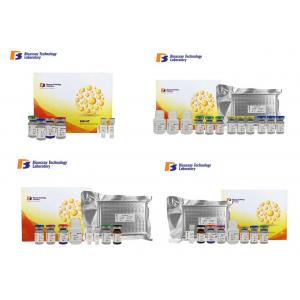96 Wells Size Sandwich ELISA Kit / Mouse ELISA Kit GAL8 5.56ng/L Sensitivity
Add to Cart
96 Wells Size Mouse Galectin 8 Sandwich ELISA Kit Highly Sensitive
With 2 Hours Assay Time
Cat.No E0860Mo
Standard Curve Range: 10ng/L - 2000ng/L
Sensitivity: 5.56ng/L
Precautions
- Prior to use, the sandwich elisa kit and sample should be warmed naturally to room temperature 30 minutes.
- This instruction must be strictly followed in the experiment.
- Once the desired number of strips has been removed, immediately reseal the bag to protect the remain from deterioration. Cover all reagents when not in use.
- Make sure pipetting order and rate of addition from well-to-well when pipetting reagents.
- Pipette tips and plate sealer in hand should be clean and disposable to avoid cross-contamination.
- Avoid using the reagents from different batches together.
- Substrate solution B is sensitive to light, don’t expose substrate solution B to light for a long time.
- Stop solution contains acid. Please wear eye, hand and skin protection when using this material. Avoid contact of skin or mucous membranes with kit reagent.
- The sandwich elisa kit should not be used beyond the expiration date.
*This product is for research use only, not for use in diagnosis
procedures. It’s highly recommend to read this instruction entirely
before use.
Assay Principle
This sandwich elisa kit is an Enzyme-Linked Immunosorbent Assay
(ELISA). The plate has been pre-coated with Mouse GAL8 antibody.
GAL8 present in the sample is added and binds to antibodies coated
on the wells. And then biotinylated Mouse GAL8 Antibody is added
and binds to GAL8 in the sample. Then Streptavidin-HRP is added and
binds to the Biotinylated GAL8 antibody. After incubation unbound
Streptavidin-HRP is washed away during a washing step. Substrate
solution is then added and color develops in proportion to the
amount of Mouse GAL8. The reaction is terminated by addition of
acidic stop solution and absorbance is measured at 450 nm.
Intended Use
This sandwich kit is for the accurate quantitative detection of
Mouse Galectin 8 (also known as GAL8) in serum, plasma, cell
culture supernates, cell lysates, tissue homogenates.
Reagent Provided
| Components | Quantity |
| Standard Solution (2400ng/L) | 0.5ml x1 |
| Pre-coated ELISA Plate | 12 * 8 well strips x1 |
| Standard Diluent | 3ml x1 |
| Streptavidin-HRP | 6ml x1 |
| Stop Solution | 6ml x1 |
| Substrate Solution A | 6ml x1 |
| Substrate Solution B | 6ml x1 |
| Wash Buffer Concentrate (25x) | 20ml x1 |
| Biotinylated Mouse GAL8 Antibody | 1ml x1 |
| User Instruction | 1 |
| Plate Sealer | 2 pics |
| Zipper bag | 1 pic |
Reagent Preparation
All reagents should be brought to room temperature before use.
Standard Reconstitute the 120μl of the standard (2400ng/L) with 120μl of
standard diluent to generate a 1200ng/L standard stock solution.
Allow the standard to sit for 15 mins with gentle agitation prior
to making dilutions. Prepare duplicate standard points by serially
diluting the standard stock solution (1200ng/L) 1:2 with standard
diluent to produce 600ng/L, 300ng/L, 150ng/L and 75ng/L solutions.
Standard diluent serves as the zero standard(0 ng/L). Any remaining
solution should be frozen at -20°C and used within one month.
Dilution of standard solutions suggested are as follows:
| 1200ng/L | Standard No.5 | 120μl Original Standard + 120μl Standard Diluent |
| 600ng/L | Standard No.4 | 120μl Standard No.5 + 120μl Standard Diluent |
| 300ng/L | Standard No.3 | 120μl Standard No.4 + 120μl Standard Diluent |
| 150ng/L | Standard No.2 | 120μl Standard No.3 + 120μl Standard Diluent |
| 75ng/L | Standard No.1 | 120μl Standard No.2 + 120μl Standard Diluent |
| Standard Concentration | Standard No.5 | Standard No.4 | Standard No.3 | Standard No.2 | Standard No.1 |
| 2400ng/L | 1200ng/L | 600ng/L | 300ng/L | 150ng/L | 75ng/L |
Wash Buffer Dilute 20ml of Wash Buffer Concentrate 25x into deionized or
distilled water to yield 500 ml of 1x Wash Buffer. If crystals have
formed in the concentrate, mix gently until the crystals have
completely dissolved.
Summary
1. Prepare all reagents, samples and standards.
2. Add sample and ELISA reagent into each well. Incubate for 1 hour
at 37°C.
3. Wash the plate 5 times.
4. Add substrate solution A and B. Incubate for 10 minutes at 37°C.
5. Add stop solution and color develops.
6. Read the OD value within 10 minutes.
Calculation of Result
Construct a standard curve by plotting the average OD for each
standard on the vertical (Y) axis against the concentration on the
horizontal (X) axis and draw a best fit curve through the points on
the graph. These calculations can be best performed with
computer-based curve-fitting software and the best fit line can be
determined by regression analysis.




